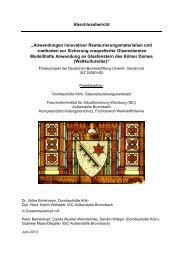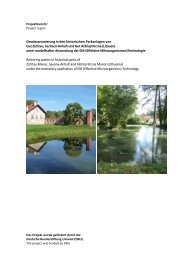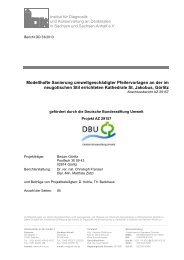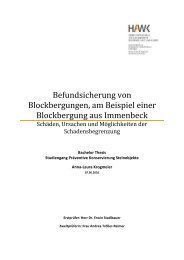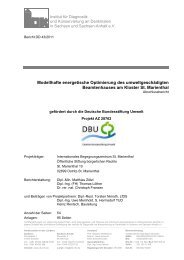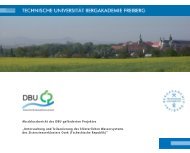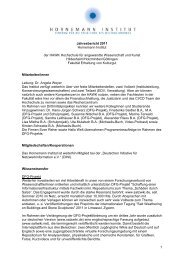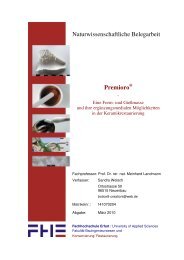Download PDF
Download PDF
Download PDF
Sie wollen auch ein ePaper? Erhöhen Sie die Reichweite Ihrer Titel.
YUMPU macht aus Druck-PDFs automatisch weboptimierte ePaper, die Google liebt.
Weichmacherverlust bei PVC-Objekten von Joseph Beuys – Versuche zu kurativen und konservatorischen Massnahmen<br />
ANHANG III: ZUSAMMENSTELLUNG VON ABSTRACTS<br />
Jayakrishnan, A; Lakshmi, S. (1998): Immobile plasticizer in flexible PVC. In: Nature 396, 638 (1998)<br />
Plasticized poly(vinyl chloride) (PVC) is one of the most widely used polymeric materials in medical and related<br />
applications, and usually contains up to 40 per cent di-(2-ethylhexyl)phthalate (DEHP), which acts as the 'plasticizer'<br />
to impart flexibility to an otherwise rigid PVC. The plasticizer can migrate from PVC-based devices and storage bags<br />
into physiological fluids, however, and has been detected in storage media such as blood, plasma, serum, drug<br />
solutions and fatty foods, as well as in the bodies of patients undergoing haemodialysis and transfusion. This is a<br />
concern because DEHP is a lipid-removing liver carcinogen, and causes hepatic and reproductive toxicity in rodents,<br />
although opinion is divided on its toxicity in humans.<br />
Jayakrishnan A.; Sunny, M. C. (1996): Phase transfer catalysed surface modification of plasticized<br />
poly(vinyl chloride) in aqueous media to retard plasticizer migration. In: Polymer, Volume 37, Issue 23 ,<br />
November 1996, S. 5213-5218<br />
Plasticized poly(vinyl chloride) (PVC) sheets were surface modified by nucleophilic substitution of chlorine by azide in<br />
aqueous media under phase transfer conditions. PVC was reacted with a 40% solution of sodium azide in water<br />
using tetrabutyl ammonium bromide as the phase transfer catalyst. The reaction was conducted at temperatures<br />
ranging from 50 to 80°C for various periods of time (1–4 h). The azidated PVC surface was then irradiated using u.v.<br />
light with a 125 W lamp for various time periods to crosslink the surface. Migration of the plasticizer di-(2-ethylhexyl<br />
phthalate) from surface modified and unmodified PVC was examined in a potential organic extractant such as<br />
hexane. It was found that considerable reduction in the migration of the plasticizer could be achieved by this<br />
technique depending on the extent of azidation of the PVC surface and the irradiation dose. Determination of the<br />
stress/strain properties of PVC sheets before and after modification showed that there was around 30% reduction in<br />
these properties after surface modification. However, the values were still much above the minimum prescribed for<br />
vinyl chloride polymers used in biomedical applications.<br />
Bildung einer weichmacherfreien Schicht<br />
Place, S.; Fugit, J. L.; Prochazka, F.; Taverdet, J. L. (2003): A rheological and morphological study of<br />
treated PVC. In: Journal of Applied Polymer Science, Volume 90, Issue 13, Date: 20 December 2003, S. 3497-<br />
3502<br />
This article reports a rheological and morphological study of poly(vinyl chloride) (PVC) that was subjected to a<br />
treatment capable of decreasing the simultaneous mass transfers occurring between liquid food (or simulant) and<br />
PVC packaging. The storage modulus (G), loss modulus (G), and the loss angle (tan ), have been used to determine<br />
the glass transition temperature using a Rheometric Scientific Dynamic Analyzer. Young's modulus was measured on<br />
a dynamometer, and a morphological characterization was carried out with an optical microscope. The obtained<br />
results show that treated PVC behaves like a composite material, which is in agreement with a previously established<br />
model.<br />
Fugit, Jean-Luc; Taverdet, Jean-Louis; Gauvrit, Jean-Yves; Lanteri, Pierre (2003): Treatment of plasticized PVC<br />
to reduce plasticizer/solvent migration: optimization with an experimental design. In: Polymer<br />
International, Volume 52, Issue 5, Date: May 2003, S. 670-675<br />
This work deals with mass transfers between liquid food and PVC packaging. A treatment which reduces the<br />
migration both of plasticizer toward a liquid food simulant and the liquid has been investigated. The treatment is a




